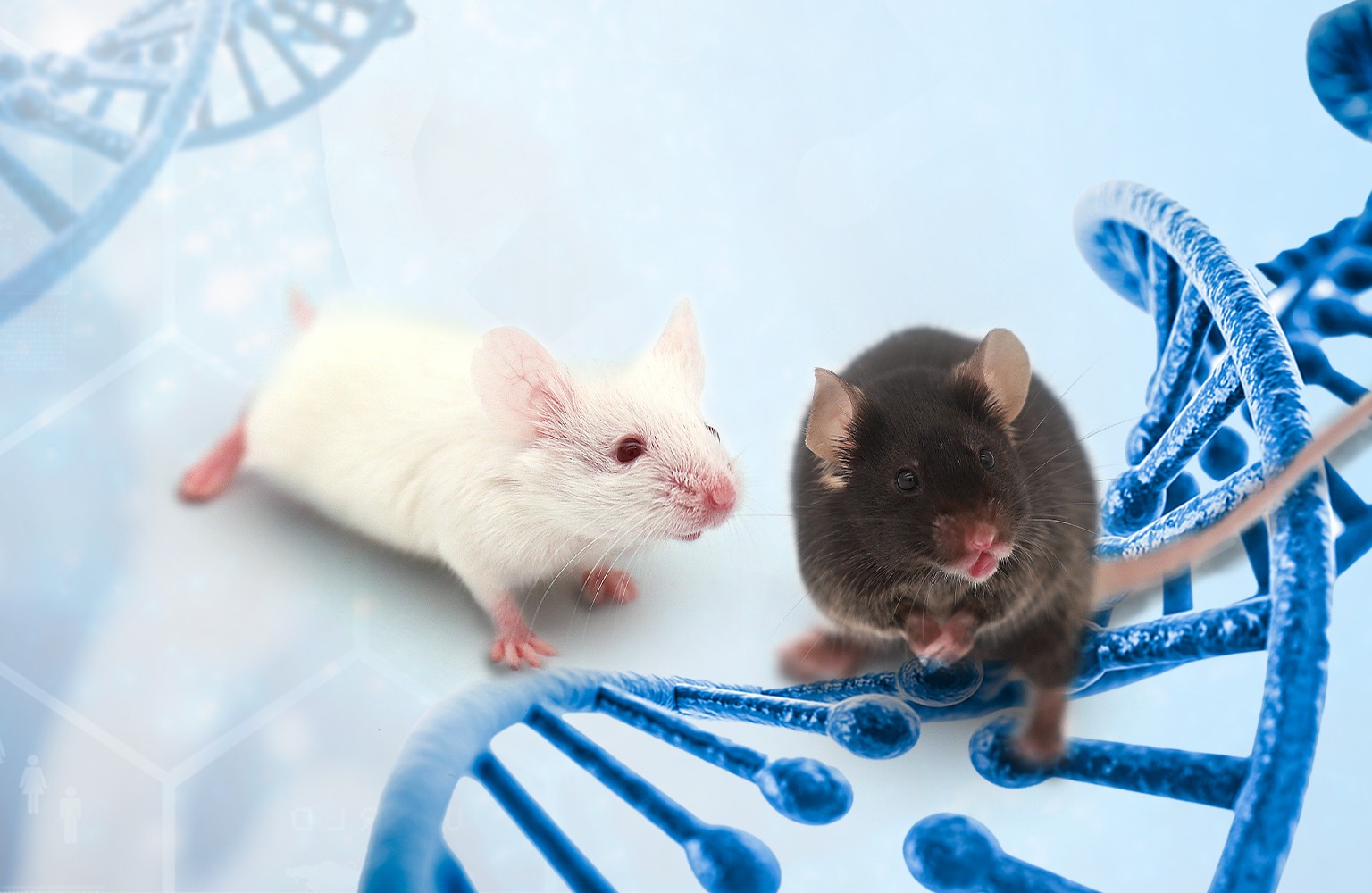
huHSC-NCG
huHSC-NCG小鼠是将人造血干细胞 (CD34+HSC)移植到辐照清髓的重度免疫缺陷小鼠NCG体内,并分化产生各类造血或者免疫细胞,如T细胞、B细胞以及NK细胞等,从而获得免疫系统人源化的模型以NCG小鼠为受体鼠,构建huHSC-NCG人源化小鼠。
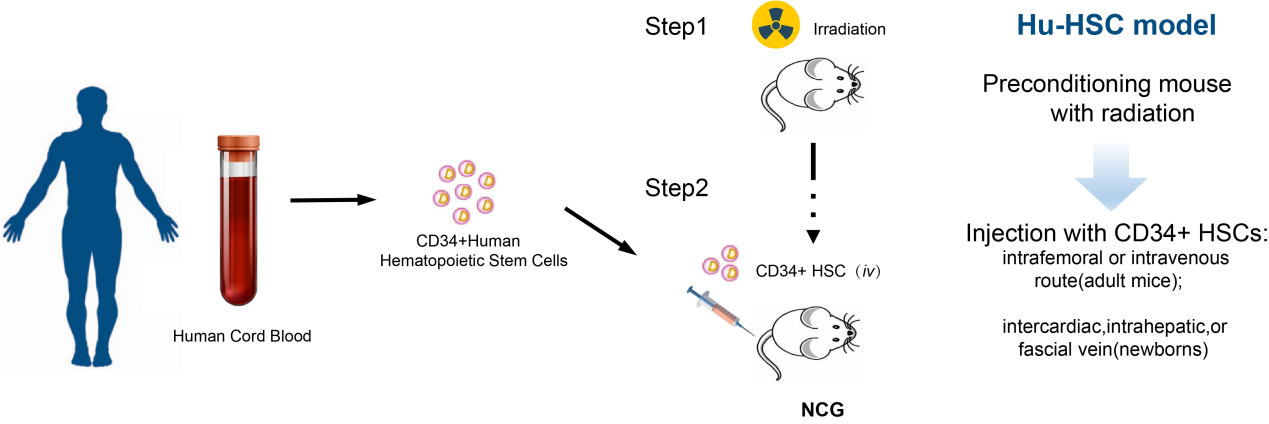
应用领域
1. 多种肿瘤免疫治疗药物的评价
2. 免疫相关的药物评价
模型数据
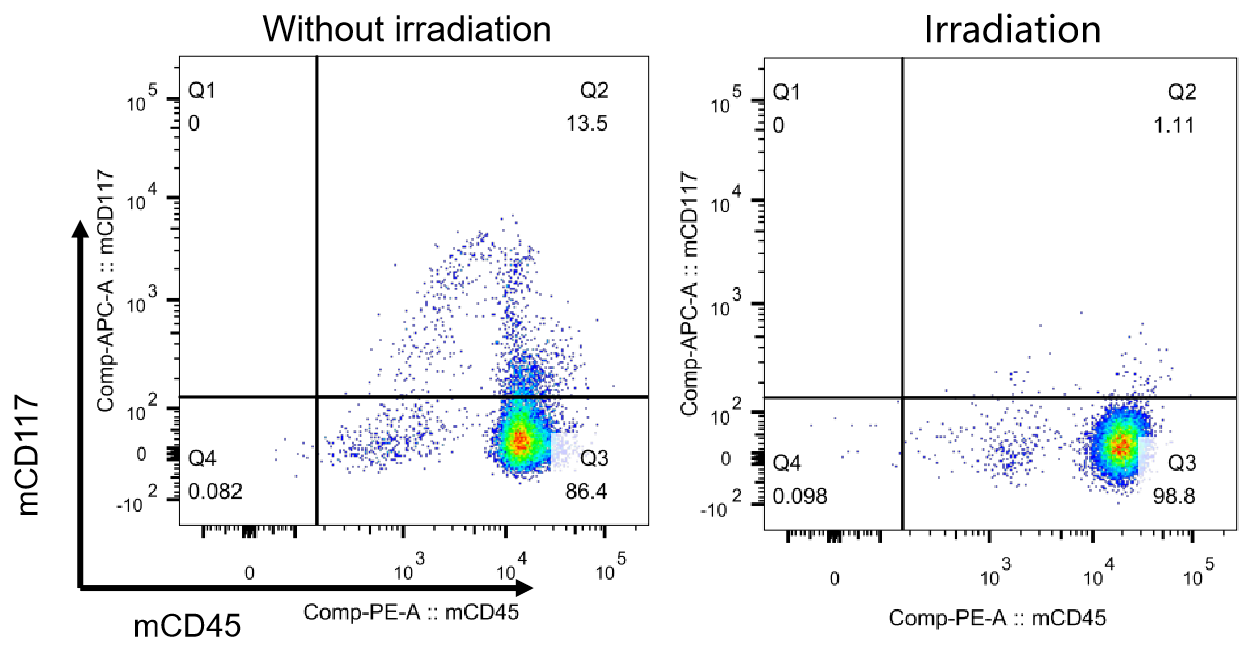
图1. NCG小鼠清髓效果检测
由于辐照可以清除小鼠骨髓中的造血干细胞,从而提高人源HSC移植后的重建水平,因此选用辐照处理后的NCG小鼠移植人源HSC。利用流式细胞技术检测辐照清髓效果。其中mCD45为小鼠白细胞标记物,mCD117为造血干细胞标记物。上图显示辐照后mCD45+mCD117+细胞群体比例为1.11%,显著低于未辐照组(13.5%)。表明150 cGys剂量辐照6-7周NCG小鼠可达到理想的清髓效果。
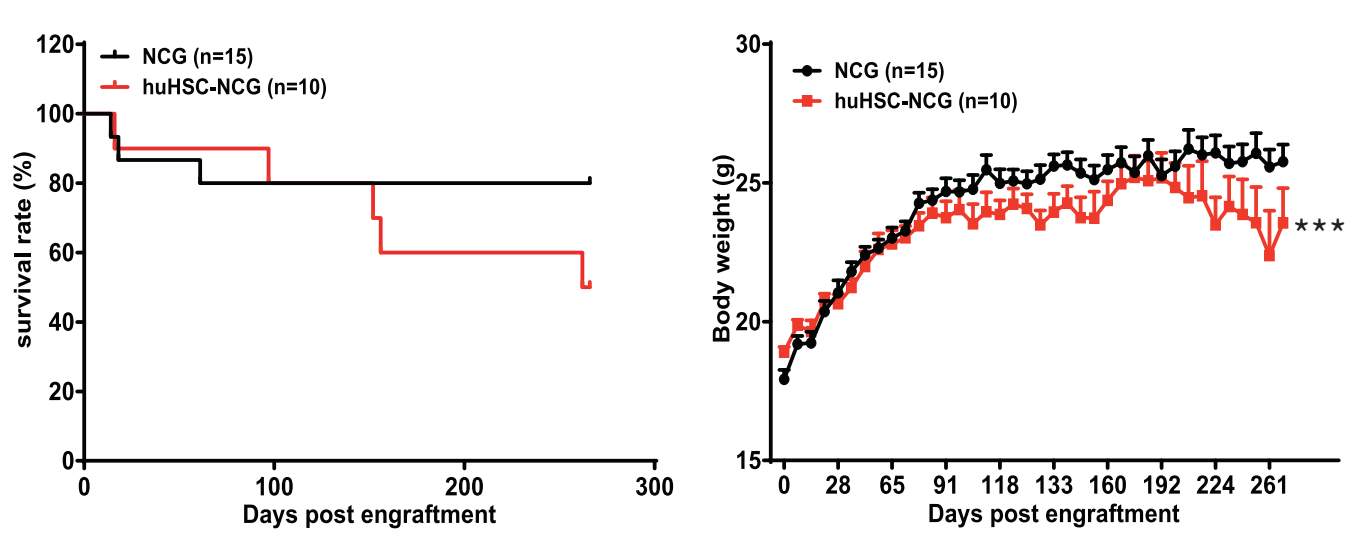
图2. huHSC-NCG小鼠的生存曲线及体重变化情况
huHSC-NCG小鼠存活时间可超过37周,且生存率与NCG野生型小鼠无显著差异。huHSC-NCG小鼠体重随时间变化呈增长趋势,前期与NCG野生型小鼠体重无显著差异,随着时间延长,huHSC-NCG小鼠体重下降,在实验终点,huHSC-NCG小鼠体重显著低于NCG野生小鼠(***, P < 0.001)。数据以Mean ± SEM形式呈现。
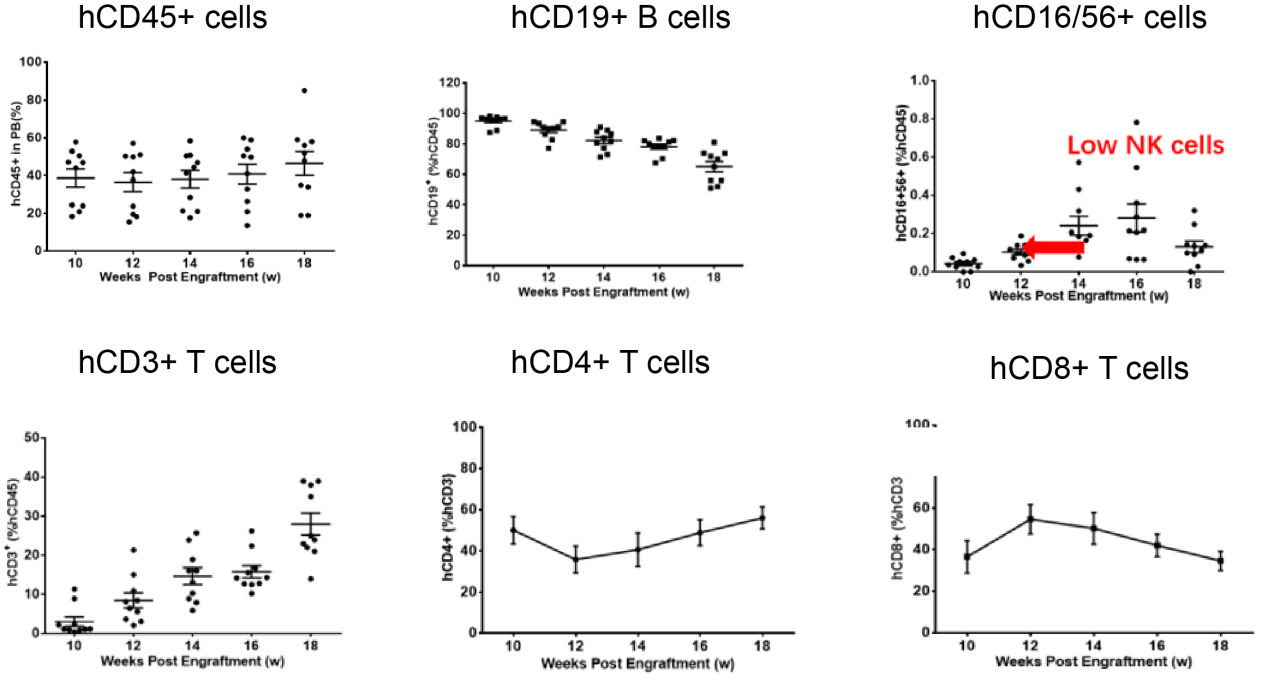
图3. huHSC-NCG重建效果鉴定
huHSC-NCG小鼠的免疫重建效率高,主要重建T细胞和大量未成熟的B细胞,以及少量NK细胞。
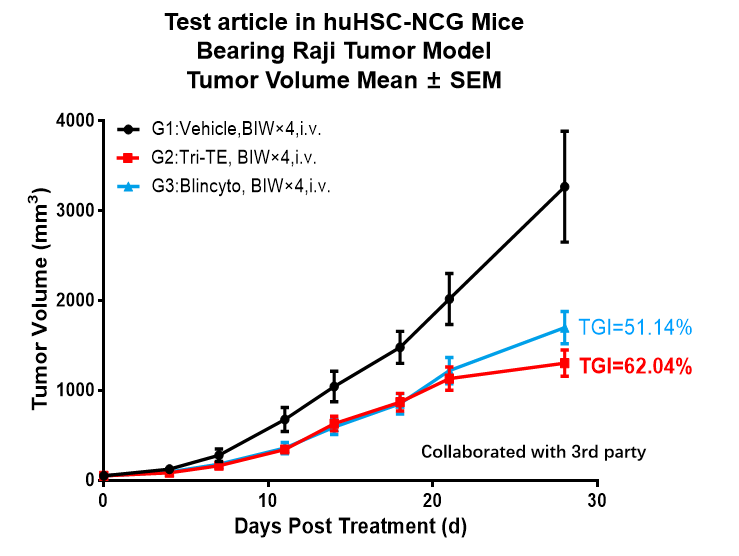
图4. 基于huHSC-NCG小鼠模型的体内药效评价
基于huHSC-NCG小鼠体内用药试验。将对数生长期人淋巴瘤细胞Raji细胞接种到huHSC-NCG小鼠皮下,待肿瘤生长至平均体积约40-50 mm3时,根据小鼠肿瘤体积和体重,随机分为Vehicle组,Tri-TE给药组,Blincyto给药组,并使用相应的药物进行治疗。结果显示:Tri-TE组(TGI=62.04%)及Blincyto给药组(TGI=51.14%)对huHSC-NCG的Raji细胞荷瘤鼠上肿瘤生长有抑制作用。
NCG在CAR-T治疗上的应用
CAR-T(Chimeric Antigen Receptor T Cell)是肿瘤免疫治疗的新方法。CAR-T细胞具有靶向识别肿瘤抗原的能力,其杀伤肿瘤细胞无需进行抗原递呈,与以往免疫疗法相比,具有特异性高、攻击持久等优势。在恶性肿瘤,特别是血液肿瘤治疗中有很好的疗效。集萃药康具有丰富的CDX和自主知识产权的PDX库,包括多种实体瘤和血液瘤,为CAR-T药效评价提供了丰富的肿瘤模型资源。同时,集萃药康开发了外周血中CAR-T细胞计数方法和细胞因子检测方法,满足CAR-T实验检测需求。

图5.在NCG小鼠上接种Nalm6-Luciferase后,进行CAR-T药效评价
Nalm6-Luciferase细胞尾静脉接种到NCG小鼠后,第7天根据肿瘤负荷进行分组,分别给予Control T,CAR-T1及CAR-T2细胞治疗,并于D12,D19,D26利用活体成像技术检测肿瘤负荷。据体内成像及统计结果显示,与Control T相比,CAR-T1和CAR-T2细胞均能很好的抑制小鼠体内肿瘤生长,延长小鼠生存期。
参考文献
1.
Hu B, Yu M, Ma X, et al. Interferon-a potentiates anti-PD-1 efficacy by
remodeling glucose metabolism in the hepatocellular carcinoma
microenvironment. Cancer discovery. Apr 12
2022;doi:10.1158/2159-8290.Cd-21-1022(IF:39.397)
2. Ma W, Yang Y, Zhu J, et al. Biomimetic Nanoerythrosome‐Coated Aptamer‐DNA Tetrahedron/Maytansine Conjugates: pH‐Responsive and Targeted Cytotoxicity for HER2‐positive Breast Cancer. Advanced Materials.2109609.(IF:30.849)
3. Song H, Liu D, Wang L, et al. Methyltransferase like 7B is a potential therapeutic target for reversing EGFR-TKIs resistance in lung adenocarcinoma. Molecular cancer. Feb 10 2022;21(1):43. (IF:41.444)
4. Zhang L, Zhu Z, Yan H, et al. Creatine promotes cancer metastasis through activation of Smad2/3. Cell metabolism. 2021;33(6):1111-1123. e4.(IF:22.4)
5. Liu C, Zou W, Nie D, et al. Loss of PRMT7 reprograms glycine metabolism to selectively eradicate leukemia stem cells in CML. Cell Metab. Apr 26 2022.(IF:22.4)
6. Zhang X-N, Yang K-D, Chen C, et al. Pericytes augment glioblastoma cell resistance to temozolomide through CCL5-CCR5 paracrine signaling. Cell Research. 2021:1-16. (IF:25.617)
7. Dai Z, Mu W, Zhao Y, et al. T cells expressing CD5/CD7 bispecific chimeric antigen receptors with fully human heavy-chain-only domains mitigate tumor antigen escape. Signal transduction and targeted therapy. Mar 25 2022;7(1):85.(IF:18.187)
8. Dai Z, Liu H, Liao J, et al. N7-Methylguanosine tRNA modification enhances oncogenic mRNA translation and promotes intrahepatic cholangiocarcinoma progression. Molecular Cell. 2021. (IF:17.97)
9. Hao M, Hou S, Li W, et al. Combination of metabolic intervention and T cell therapy enhances solid tumor immunotherapy. Science Translational Medicine. 2020;12(571).(IF:17.956)
10. Liu Y, Liu G, Wang J, et al. Chimeric STAR receptors using TCR machinery mediate robust responses against solid tumors. Science Translational Medicine. 2021;13(586).(IF:17.956)
11. Yan H, Wang Z, Sun Y, Hu L, Bu P. Cytoplasmic NEAT1 Suppresses AML Stem Cell Self‐Renewal and Leukemogenesis through Inactivation of Wnt Signaling. Advanced Science. 2021;8(22):2100914. (IF:17.521)
12. Luo Q, Wu X, Chang W, et al. ARID1A prevents squamous cell carcinoma initiation and chemoresistance by antagonizing pRb/E2F1/c-Myc-mediated cancer stemness. Cell Death & Differentiation. 2020;27(6):1981-1997. (IF:12.067)
13. Wu M, Zhang X, Zhang W, et al. Cancer stem cell regulated phenotypic plasticity protects metastasized cancer cells from ferroptosis. Nature communications. Mar 16 2022;13(1):1371.(IF:14.919)
14. Liu H, Bai L, Huang L, et al. Bispecific antibody targeting TROP2xCD3 suppresses tumor growth of triple negative breast cancer. Journal for ImmunoTherapy of Cancer. 2021;9(10):e003468.(IF:12.469)

